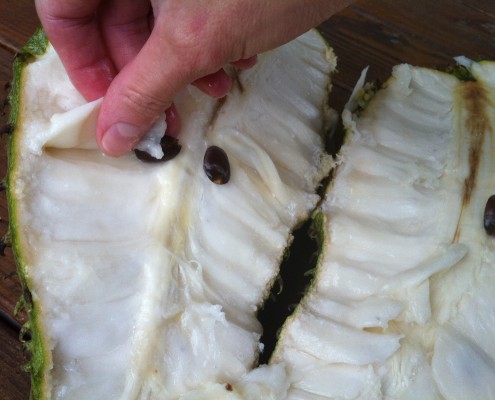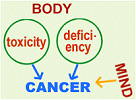This collection of case studies (originally as pdf-files) come from the Gerson Institute, and is for those who cannot read pdf-files.
Find more case studies here, e.g. doctors healing their own cancers.
If you are diagnosed with cancer – WHAT TO DO
Find a list of cancers here, cancers that have been reversed with Gerson therapy.
Healing Brain & Kidney Cancer, The Gerson Way, by Charlotte Gerson
Kenneth Edward Titus – Brain Tumour
Kenneth Edward Titus had problems with repeated falls. In June 1982, he went to his Kaiser doctor who, among other tests, carried out a needle biopsy on his brain. This produced a diagnosis of astrocytoma (brain cancer), very bad news indeed, which was given to the patient on his birthday, June 25 th . Edward consulted two other doctors for their “second opinions,” but the diagnosis and the prognosis were the same: he would be dead by Christmas.
Surgery was offered as a treatment option. However, Edward had a friend who some six months earlier had submitted to surgery for a brain tumour. He had emerged from the surgery reduced to the status of a vegetable, and had died shortly before Edward was given his diagnosis. With this experience fresh in his mind, he refused surgery. He didn’t tell anybody what the problem was, and told his family that he had had a myelogram. When he continued to have episodes of falling, it was assumed that he was drunk.
By the end of September 1982, Edward’s family found out what his problem was, and his brother and sister started to investigate alternative therapies, including the Burton treatment and the Gerson Therapy. Edward chose the Gerson Therapy, because he hated the thought of so many needles (as used by Burton). He arrived at the Hospital La Gloria in Mexico on October 1, 1982 to start treatment. He was not at all sure about the Gerson Therapy, and suspected that it was quackery. So, after being evaluated at the Gerson Therapy hospital, he left to go back to his business. At any rate, he felt that he “couldn’t spare the time” to take any treatment!
However, in early December, he was back at La Gloria. By then he was extremely weak, unable to walk, and blind. He remembers that he went two days on the Therapy without taking any enemas, being simply embarrassed to admit that he was unable to take them. By that time he was “like a zombie”, being highly toxic. Edward was convinced that he was going to die – but wanted to die away from his family, at the Mexican hospital. Yet after about three weeks at La Gloria, before it was time to leave, he was able to run up and downstairs. On Christmas Day his brother came to visit and was “shocked” at the tremendous change in Edward. By then his eyesight had also returned.
When he got home, he still spent a lot of time resting in bed, and his brother and sister took complete care of him, besides working at their own full-time jobs. In time, he got well; his eyesight reverted to the stage where he was able to use the same eyeglass prescription as he had done at age 17. He now feels in “perfect health”. But when he went back to the Kaiser hospital, he found that they had “lost” his records, as had the other two doctors to whom he went for second opinions. Inexplicably, they “knew nothing about him,” and had no records!
Titus now has a winter home in Puerto Vallarta, and spends the summer months in Oregon. He says that he remembers relatively little about his whole extraordinary experience, it is totally “behind him”. In his book, A Cancer Therapy, Dr. Gerson repeatedly states that when a patient “forgets” about his cancer experience, when his fear and panic are gone, he is really cured. It has now been more than 20 years since Edward was given six months to live, and he is healthy and alive today!
David Saracoff – Kidney cancer
In October of 1990, in his 58 th year, David was diagnosed with kidney cancer that had spread to both kidneys. He had originally gone to his urologist because an enlarged prostate was causing some problems with urination. While being initially treated for this condition, he was also given an I.V.P. (Intravenous Pyelogram) test for visualising kidneys. This test revealed “a depression, like something was pressing on his kidney”. To check further, a CAT scan was done. Nothing showed outside of his kidneys. However, multiple tumours were visible in both kidneys: five or six in the right kidney, and three in the left. A needle biopsy done on the largest tumour tested positive for a fast-moving malignancy.
The doctor told David that the tumours could not be removed because they were too close to the major blood supply to the kidneys. “This is the worst possible scenario I can imagine,” he said, and proposed a swift entire removal of both kidneys. This operation of course would have required David to receive regular dialysis for the rest of his life. When David refused to undergo this surgery, another doctor sent him to UCLA to see about entering an experimental programme using interferon. However, the UCLA oncologist wouldn’t allow David to participate in this trial. There was a chance, he declared, that David’s cancerous condition was “curable” if both his kidneys were removed.
At this point, David was sent back to his surgeon/urologist for the dual nephrectomy. When David asked about the possibility of receiving a kidney transplant, he was told that this would be impossible. The immunosuppressive drugs he would have to take to prevent his body from rejecting the donated kidney almost certainly would cause his cancer to recur. David was also informed that if he attempted to try some nutritional treatment first, which he was now considering doing, it probably would be too late to do surgery since the cancer doubtless would spread. Nevertheless, David again refused to have his kidneys removed.
Instead, in January of 1991, David came to the Gerson Therapy Hospital in Mexico. After checking in, his first urinalysis, showed a slight amount of blood in his urine. None showed in any of his subsequent tests. When returning home after some three weeks, David maintained the strict therapy for two years, and then continued on a less intensive treatment. Six years later, his regimen was reduced to four carrot juices and one green juice daily, and a coffee enema every other day. He still does the castor oil treatment every other month.
Since kidney cancer tends to spread to the lungs, some months ago David had lung x-rays taken; his lungs showed clear. He has blood tests and urinalyses done regularly. David reported that his doctor commented, “I never see blood test this good, they are better than my own.”
Surprisingly, tumours still show in David’s kidneys when they are scanned. At the time of his diagnosis and biopsy, in 1990, these were described as fast-growing malignancies. But since the tumours remain unchanged and no other cancer has appeared in his body for the past 11 years, it is fairly safe to assume that the tumours are either calcified and virtually dead, or else encapsulated. If they were active, they would be growing and/or spreading.
Last report: October 2001. At that time, David Saracoff was close to his 69 th birthday. He was currently in good health, had fair energy, his weight was steady, his appetite and sleep normal. He was pain-free. “I am fairly active,” he said. “I bought a motor home and took a trip back East for seven weeks. And I also went camping”.
Healing Breast Cancer, The Gerson Way
Janet Pottinger – Breast cancer
In 1987 Janet Pottinger was diagnosed with an in-situ intraductal carcinoma of the right breast. At that time she had a successful career that often required her to attend business luncheons and dinners. In 1984, she had travelled to China on a holiday and had received several vaccinations, with boosters in 1985. Following these, she felt less and less well, but had no specific symptoms. (For further discussion of the problem of vaccinations, see Confessions of a Medical Heretic, by Robert Mendelsohn, M.D.)
After seeing a homeopath in 1987 for several symptoms, Janet decided to have a complete checkup. It didn’t register at the time that the nurse was spending a lot of time during the checkup on Janet’s breast screening, nor did the need for a second mammogram alarm her, “because the first one was unclear, which might have been a problem with the machine.”
Two weeks later her general practitioner suggested that she sees a specialist, but Janet was just too tired to think of any serious problem. She consulted a surgeon who never mentioned the word “cancer”, but said that “something” had shown on the mammogram, and Janet needed surgery urgently. He said he had no idea “how long it had been there” [emphasis ours]. Janet and her husband drove home “in dejected, stunned silence and then, at home, hugged and cried a lot”. A few days later she had a lumpectomy at the Cromwell Hospital in London. She specifically forbade the surgeon to remove anything but the lump – (“We were still not using the word ‘cancer’, she said), no mastectomy, no lymph node dissection. She went home the day after the operation, “shaken, scared but relieved.”
“What I’d dreaded most about the operation was having the anesthesia and being completely in the hands of other people, at their mercy”. Early one morning, soon after the operation, the surgeon called to say that the tissue was malignant but that he had “got it all out!” Janet continues, “The beautiful summer day suddenly looked brighter and sunnier and the sky was bluer. My husband and I went on a gentle stroll in the park. But by the evening of the same day the surgeon urgently called to see me again. By 9:30 PM we were in his office. He told us that in his experience there was a 50/50 chance for my tumour to recur, and that a mastectomy would keep it from coming back. If it did recur, there was again a 50/50 chance that it would be more invasive.”
Janet seriously started to phone around and talk to friends about options. Among others, she found Beata Bishop, who listened and suggested that they meet. From Beata, Janet learned about Gerson, but still sought other medical opinions. A radiologist recommended, “Radiation tomorrow morning”. Another surgeon insisted, “More surgery”. She did neither. Two years later, and six months after a business upset, in August 1989, her cancer was back again in the same place. At the end of that month Janet came to the Gerson Healing Centre in Mexico, after arranging her household to return home to the full Gerson Therapy. “One afternoon in January 1990 I woke up from a sleep, and as I woke, I knew I had no more cancer. It was gone. I was sure.” In April a homeopath confirmed that there was no more cancer. In January 1991 Janet had another mammogram from her surgeon. He couldn’t bring himself to admit that she was clear; instead, he shouted at his nurse for supposedly doing something wrong with the files. Finally Janet asked,
“Does the mammogram show the scar tissue from the ’87 operation?”
“No, there’s no scar tissue.”
“Is there a tumour?”
“No, nothing.”
The surgeon didn’t charge for that consultation.
Healing Colon, Liver and Pancreas Cancer, The Gerson Way, by Charlotte Gerson
Ella Augenti – Colon Cancer, Grave’s Disease, Hypoglycemia; Glaucoma, Concussion
Ella was born in 1916. When interviewed, in late 2000, she was 84 years old. It is almost incredible; however she did, in the course of her lifetime, suffer from all the above ailments. In 1928 when she was only 12 years old, her mother was diagnosed with tuberculosis. She found Dr. Gerson in New York, did the Gerson Therapy, recovered, and lived 12 years in good health. Due to an auto accident, she had very severe injuries, bleeding the doctors were unable to stop. She died shortly thereafter. When she was 30 years old, Ella found herself in an extremely stressful marriage. She developed Grave’s Disease (Exophthalmic goiter) and returned to Dr. Gerson in New York, followed his advice, and reported “I got well quickly while dieting with my mother”. The disease never recurred.
Later she suffered from hypoglycemia but didn’t know where to find the Gerson Therapy. She went to doctors who put her on a high protein diet. This caused her severe dizziness – so she stopped. She told that “By the greatest good luck, my niece had gotten a health food store and had received notice that Charlotte Gerson was going to lecture in Asbury Park (New Jersey). I was so thankful to find her; and went back on the [Gerson] diet and got rid of that problem.”
It was at age 71 that Ella noted rectal bleeding. Since she seriously distrusted doctors, she assumed that it was caused by haemorrhoids. Eventually, due to some problems of elimination, she did consult a doctor who found “a very large tumour”. The medical report of the surgery at Pascack Valley Hospital in New Jersey, by Dr. F. Candido, confirmed adeno-carcinoma of the rectum, with extensive small and large bowel adhesions.
She refused orthodox treatments and at the end of 1987 went to Mexico for the Gerson Therapy. She said, “I knew where to go when I got cancer.” She got a good response. After some time, she found it very cumbersome to pick up and carry her distilled water home. Instead, she opted for home delivery of her water. At that time, she worsened but only discovered later that the ‘delivered’ water was not distilled and contained salt. In 1988, since her tumour was growing, she had to have it removed. At about the same time, Ella was diagnosed with glaucoma. With the Gerson Therapy, and back on distilled water, she completely cleared the cancer as well as the glaucoma. She felt that the niacin, especially, helped to open the ducts in her eyes to reduce the pressure.
Most recent news: August 2001. At that time, she said that she needed no medication and has no further problems, no recurrence of her colon cancer. “I feel just fine, and when people talk to me on the phone, they can’t believe I am 84; because, they say, my voice sounds so energetic.” Last year, she slipped and fell on the ice, had a severe blow on the back of her head that caused a concussion. She landed in the hospital for four days but couldn’t wait to get home to do the proper Gerson Therapy. Soon her doctors were amazed at her excellent recovery – at age 83. Ella had no more headaches or any other problems due to the fall.
Patricia Ainey – Pancreatic Cancer
In January 1986, Patricia was sent by her doctor from her residence in Nanimo (BC, Canada) to Victoria for a CAT scan. The results were verified by a needle biopsy. The medical specialist said to her, “Go home and get your life in order; the cancer is so bad it is inoperable.” She was also told that the malignancy had spread to her liver, gallbladder and spleen. By then she had lost more than 45 pounds and was vomiting blood. Naturally, the medical verdict distressed Patricia greatly. After much anguish and weeping she decided to make the best of the few months left to her with her family.
Patricia was skeptical when she first heard about a nutritional treatment claiming to heal cancer, called the Gerson Therapy, and thought it had to be a scam. But then she and her husband read about a Victoria man who had apparently recovered from pancreatic cancer on this therapy (see George Birney) and wondered whether she should give it a try. Finally on March 7, 1986, she arrived at the Mexican Gerson clinic.
Already after ten days she began to feel considerably better than she had in months. By December of that year, her doctor told her that “he thought Patricia had the cancer licked.” He went on to say what many other physicians have told their patients who had recovered on the Gerson Therapy: “I don’t know what you are doing, I don’t want to know, just keep doing it.” In February 1990 her family physician wrote a letter in which he stated the following: “Patricia was diagnosed as having a malignancy of her pancreas. She received treatment of her disease outside of Canada, and I am pleased to say that as of the present time she has no evidence of recurrence of the disease, and what evidence of malignancy was present in 1985 has now gone.”
Although she has enjoyed excellent health for many years, Patricia still drinks the freshly made organic fruit and vegetable juices that are a mainstay of the Gerson Therapy, and has the occasional coffee enema, to ensure her continued well-being. She leads an active life and enjoys the company of her grandchildren, sixteen years after being told that her life was over. Last contact: a Christmas card received in 2001.
Professor Yoshihiko Hoshino, M.D. – Colon Cancer with Liver Metastases
It is always a pleasant surprise when an unknown person from some remote part of the world gets in touch with Charlotte Gerson, to report on his or her recovery from some serious life-threatening condition on the Gerson Therapy, solely with the help of Dr. Gerson’s classic book, A Cancer Therapy – Results of Fifty Cases.
One such occasion was on December 30, 1997, when a letter arrived from Professor Hoshino, M.D., who teaches at the Fukushima Medical College in Fukushima, Northern Japan. By then Dr. Gerson’s book had appeared in a Japanese translation, which explains how Professor Hoshino had found out about the Gerson Therapy.
According to his letter, in 1992 Professor Hoshino was diagnosed with colon cancer, which had spread to his liver, he recovered from both by using the Gerson Therapy and other immune therapy. He added, “Now I am writing a book introducing the Gerson Therapy to Japan. This will be the first book about the Therapy written by a medical doctor in Japan.”
In the fall of 1998, his book was published. In it the Professor described not only his own recovery on the Gerson Therapy, but also how, while curing himself, he also treated some twelve cancer patients. The latter belonged to various age groups and suffered from a variety of cancers, including a child with a brain tumour. All those patients made a full recovery. Our only regret is that, owing to the obvious language difficulty, we are unable to read this pioneering work.
Answering to a query from the Gerson Institute, Professor Yoshihiko sent a message on October 28, 2001, in which he confirmed that he had never had any chemotherapy, having refused it as an option. Instead, he wrote, “I treated my disease by operation for the colon cancer, and with the Gerson Therapy and urine therapy for the liver cancer.”
Healing Lung Cancer & Respiratory Diseases, The Gerson Way, by Charlotte Gerson
John Peters – Lung Cancer and Myasthenia Gravis
In mid-August 1989 John Peters turned 60 years of age. He was working out regularly, and five days a week was also swimming 1000 yards. He had never been a smoker, ate a good diet, and had only missed work once in 30 years. After giving him his annual examination, his doctor pronounced him in excellent health.
Just two months later, however, he had a persistent cough. In November he underwent open chest surgery for non-small cell lung cancer. The operation was followed by 24 radiation treatments which seemed to work – for a while. About a year later, he developed another cough and began losing weight, strength and energy. “I was like a wind-up toy that was running down” he later recalled of this time, “and the doctors were not helping.”
After being hospitalised for a bronchoscopic examination, Mr. Peters’ physician said that he would again have to have open-chest surgery to remove the recurring cancer. When he refused both surgery and chemotherapy, they told him that he had no chance for survival.
“I had researched lung cancer, and realised that the only reason I got cancer was that my body supported it”, he wrote when giving us the story of his recovery. “Thus, if I didn’t change the internal environment of my body, the cancer would just come back again.”
John started on the Gerson Therapy in May 1991, and he did it at home. “I was very weak and the therapy was demanding,” he said. “But I was facing the Grim Reaper and was highly motivated. In only three weeks, I knew it was working, I was getting stronger, coughing less, and feeling much better. Most surprising of all, I was actually gaining weight on this vegetarian diet after losing so much for months, I had become just skin and bones!”
About one year after starting Therapy, John Peters reported, he returned to his pulmonary specialist. He found out later that the physician had stated in his medical records that “the patient is fine with no sign of cancer, so our diagnosis was undoubtedly wrong.”
Before having surgery in 1989, John had obtained a second opinion from the head of the Pittsburgh Cancer Institute. In 1996, when he returned there for a follow-up test, the head physician was shocked to see him. “He said that I’d never know how lucky I was to be alive. He told me that with my disease, there was only about a 3% chance of survival.”
In a communication to the Gerson Institute in 1999, John Peters could tell us this: “I have remained cancer-free and in reasonably good health for the past seven years. I am vegan, avoid refined flour, sugar, salt, caffeine, and alcohol; and I still juice about 24 ounces per day. There is no doubt in my mind that I would have been in the cemetery six or seven years ago without the Gerson Therapy.”
But he had gone through a harrowing period earlier. In November 1992, John had suddenly began to see double. “The doctors suspected that the lung cancer had spread to my brain,” he said, “but all tests were negative. The problem went away … until the following November, when the double vision recurred. My mother and favourite uncle had both suffered from myasthenia gravis, which is what I was diagnosed with.”
The condition cleared up with medication, but again returned the following November. “After appearing for three consecutive years only in November,” Mr. Peters told us, “I asked God what this meant. But it turned out that on Halloween, I would eat leftover Halloween candy. I have not eaten candy since November 1995. And though I had been told that I was permanently disabled and would never recover, I have had no sign of myasthenia gravis since then..Last news from John Peters: November 2002. He writes that he is well and truly enjoying his two sets of twin grandchildren that, he states, “without the Gerson Therapy I would have died before getting to know them.”
Two interesting statements in this patient’s report deserve further commentary: 1 Doctors tend to reason backwards, so that if a cancer patient who was declared by them to be in a “terminal” condition somehow recovers, they assume that the diagnosis was wrong. I have some problems with this observation. Since the doctors had suggested open chest surgery and chemotherapy when the patient presented with an apparent recurrence of lung cancer, were they criminally suggesting unnecessary treatments? It is unethical and even illegal to alter medical records, yet at the Gerson Institute patients often report their doctors tell them because they got well, they had initially been misdiagnosed.
2 The other point I should point I should like to make is that this patient also recovered from myasthenia gravis. At the Gerson hospitals, we rarely see cases with this condition. Yet here we have a report that the Gerson Therapy was able to overcome this serious health problem, too.
Joan Olson – Asthma
Joan was born in Montana in 1935. She had her first asthma attack at the age of 10. It seemed to have been caused by a fall during ice skating, which injured her neck. After that, her attacks came fairly regularly, depending on the season. Mostly, they were caused by cold temperature, or by changes in the weather during fall or spring.
At the time, the family was not able to afford doctors. However, they were ranching – raising animals – and Joan had become allergic to animals of all kinds. Her worst problems, however, were with dogs, cats, and – surprisingly – by any contact with mice.
During Joan’s teenage years, her parents would take her to higher elevations, which helped to alleviate her asthma attacks. All this time, she never took drugs, since the family didn’t see physicians. At about age 20, she started to work in town, away from the ranch. She began to consult doctors about her asthma. They treated her with serum and vaccines, which helped a little, so that her attacks were less severe. In her mid-20’s Joan married a man who was 17 years older. She moved back to the family ranch, and raised three children. With all the hard work involved in the ranching lifestyle, she did suffer additional asthma attacks – and took the prescribed drugs.
Then, in 1984, her husband had a stroke. It left him without speech and paralysed on one side. For the next 13 years Joan took care of him. He was confined to a wheelchair during the day. She was also looking after the ranch, the three kids, and all the animals.
Then her husband developed prostate cancer. Joan found out about the Gerson Therapy and decided to use it with him. Joan wanted to share with as many people as possible the amazing improvements the therapy caused in her husband. Thirteen years after his stroke, having been paralysed and unable to speak all that time, when on the full therapy, his speech returned, and he also regained movement in his left side. Because his muscles had been immobilised for so long, they had atrophied. He was unwilling to do required exercises to strengthen them, but at least he did have movement again.
Meanwhile, however, Joan became totally exhausted form taking care of her invalid husband, along with obtaining and juicing the organic foods so as to give him that crucial part of the Gerson diet. She had no energy at all, and couldn’t even walk across the room. To try to improve her condition so that she could function better, Joan went on the Gerson Therapy for the first time in many years and felt “wonderful”..With all his improvements, once he felt better, her husband started to raid the refrigerator and cheat as far as the Gerson Therapy was concerned. His cancer worsened and it eventually killed him. After her husband died Joan needed to deal with all sorts of legal matters. For some while she was unable to do the therapy for herself, so that her condition worsened. Still, eventually she was able to get back on the Gerson Therapy, and she is again much better. She is able to take care of the ranch, the house and the garden … and reports that she feels she’s doing “wonderfully well”.
Healing Lymphoma, The Gerson Way, by Charlotte Gerson
Dr. Allison Sinclair – Lymphoma
Born in 1944, psychotherapist Allison was 35 years old when she first noted a firm, ill-defined mass on her neck, next to the left lobe of the thyroid. She reported to the Medical Arts Hospital of Dallas on September 12, 1979. A biopsy was performed by Dr. M.J. Waldron of the Dallas Pathology Associates. The report read: nodular lymphoma, poorly differentiated. These findings were reviewed and confirmed by Dr. M.A. Luna of M.D. Anderson Hospital, and Dr.Wm. Sheehan of the University of Texas Health Sciences Center of Dallas.
In January 1980, Allison was found to have a mass on her surgical scar that was clearly a tumour. Other nodes were found in the left cervical area, and chemotherapy was offered. Allison refused. By March 11, 1980, tumour growth was noted, and she was urged to have chemotherapy, which she once again declined. Still, her tumours were growing. By April 4, Dr. Merrick Reese of the Sammons Cancer Center at Baylor University Medical Center, who had been following her case, observed another increase of the mass. It measured 4 x 4 cm, and other nodes were also involved. Allison was a pack-a-day smoker; and suffered from the lymphoma patient’s typical night sweats. She also had family history of cancer, including two uncles suffering from lymphoma. After realising that she hadn’t taken care of her body, she began to research various diets, found information on the Gerson Therapy and decided to give it a try.
She arrived at the Gerson Therapy Hospital in Mexico on April 28, 1980, and left on May 12. Her body responded immediately with the usual healing reactions, including severe gastro-intestinal symptoms. At the same time, her local edema was receding and her large tumour began to regress during her stay at the Gerson Hospital.
Eventually all her tumours disappeared and she recovered completely. She said: “The Gerson Therapy was exactly what made sense to me, and what I needed to do, as well as to take care of stress.” Her last report was dated 1992.
Denis S. – Lymphoma
Denis (not his real name) is presently (February 2002) 64 years old. In 1986, when he was 46, he had some severe abdominal pain. In ’87, he was given a medical leave of six weeks for ‘stress, sleeplessness and lack of appetite.’ He visited various physicians but they were all unable to find anything wrong; all his tests showed normal. They finally sent him to a psychiatrist (in 1988) whom he saw for one year. This doctor gave him some pills and told him to “quit complaining about stomach aches”. Eventually he went to see an acupuncturist who was also a medical doctor. She told Denis that he was “real sick”, yet nothing showed in an upper and lower G.I. (gastro-intestinal X-ray check), nor in any blood test. The acupuncturist then sent him for an ultrasound. That is when an 8-cm tumour showed up in his spleen. A CAT scan also came up with the same finding.
In October ’90, Denis had surgery at the Palm Drive Hospital in Sebastopol (California), to remove his spleen. The surgeon reported that he had found cancer all over Denis’ intestines and throughout his abdomen, and considered his condition hopeless. When the biopsy was done, it showed a mixed large and small cell lymphoma. Denis went for a second opinion to Stanford where the diagnosis was confirmed. In January ’90 he went to Texas to try the Burzinsky treatment, stayed there a couple of weeks and then continued the treatment as directed by Dr. Burzinsky for another four months at home. He had no results, but he was no worse. He quit that treatment and did nothing for one year!
During that time, a new tumour grew. Sometime later, in late ’92, Denis started the Gerson Therapy. By that time his weight had dropped from 145 to 110 pounds. He did the Therapy mostly at home, with some support from other Gerson patients. One year later, the tumour on his small intestine had actually grown to 4.5 cm; but three months later it shrank to 2 cm.
By August 2001 he still had a 1.5 cm lymph node, which remains there, is firm but has been the same size now for about a year. The radiologist said he didn’t know any more what it might be. Denis has recovered his previous weight of about 140 lbs. and feels fine. Meantime he also helped another lymphoma patient to recover. She is in remission for “many years” (over five years).
Healing Melanoma, The Gerson Way, by Charlotte Gerson
Debbie Dole – Terminal Melanoma
Deborah Dole’s story started in early February 1978, when she was 24. She had a rash on her abdomen and consulted a dermatologist, Dr. McGinley, at Kaiser in San Francisco for a diagnosis. He noted on her right arm a black mole with a purple spot, which looked suspect to him. He biopsied it on February 15th. A few days later the pathologist reported that the mole was positive for melanoma, determined to be at Stage IV. Debbie underwent surgery on February 28th, and at that time the surgeon told her that he thought he had got it all.
Meanwhile Debbie had no new symptoms, except that the skin rash didn’t go away for a year. She did have counselling for anger with the Shanti system. In July she noticed a swelling the size of a golf ball in her right armpit. She went back to Kaiser and her doctors proposed a liver scan and surgery on the tumour, with an overall hopeless prognosis. Prior to her visit at Kaiser, Debbie had read Jaquie Davison’s book, Cancer Winner, describing here recovery from widespread terminal melanoma on the Gerson Therapy. That book had convinced Debbie that, if she ever had a recurrence, she would go the Gerson way. She called the Gerson Institute, went to the Mexican Gerson Hospital in August ’78, and started the treatment. She was very frightened and thought she was facing death. However, after six weeks she had a full-blown healing reaction with fever, nausea, redness (inflammation) and much else. After that the “golf ball” disappeared! She stayed on the full Therapy for about 14 months and then slowly got into “a more average diet”, including going out for meals. She valued sociability, and the Gerson Therapy had forced her into isolation. Also, her friends tried to discourage her, with comments like “If this therapy were any good, everybody would use it.” Only her husband and mother continued to support and encourage her. In the experience of Gerson doctors, alcohol and street drugs are often involved in cases of melanoma among young people under 30. As early as in her sophomore and junior years in High School, Debbie had used marijuana along with alcohol, often two to three times a week.
As Debbie’s Gerson Therapy months were ending, her husband became ill and was hospitalised for over a year. She visited him 2-3 times a week, while also taking care of kids where she lived during that time. In late ’89, when her mother died and her father disappeared, Debbie faced severe emotional problems. She frequently went out to dinner with a friend and had “good wine” every night. In ’92 a dear friend of hers died in a plane accident; at the same time she developed serious gynecological problems. These lasted until ’96, when she had abdominal surgery. She has been well since.
Around Christmas 2000, she went for a regular gynecological check up. The doctor felt a lump in her breast and urged her to do a mammogram. The results looked suspicious, with lumps in both breasts. He assured her that 90% of such lumps are benign, yet by late January 2001 the surgeon urged Debbie to have them removed.
However, Lent began and Debbie fasted, abandoned all indulgences, returned close to the Gerson Therapy, and “felt good, clearer, and rid of a lot of anger.” The lumps didn’t change; they didn’t grow larger and harder, nor smaller and softer. But now, aged 47, Debbie says that she feels the best she has for eight years. Her recovery from terminal melanoma totals 23 years.
Robyn Martinez Thompson – Melanoma
In 1977, during her first pregnancy, Robyn Martinez Thompson developed a growth on her right cheek. It was surgically removed, and when the biopsy proved it to be melanoma, she underwent a wide excision. The surgeon told her that the melanoma was Stage 4, but at the time she didn’t understand what that meant. She had no further treatment, and delivered a healthy baby.
Nine months later she became pregnant again and complained to her doctor that the area of the earlier deep excision felt “active” and was bothering her. But she was told that it was only “scar tissue”, and nothing further was done, since this was also late in her pregnancy.
Twelve months later she was pregnant for the third time. Now she experienced pain in the area of the surgical excision. After a biopsy she was told that the melanoma had spread to her lymph nodes, she had less than two months to live, and her unborn baby would also die. Her oncologist explained that he had to do some test, but these would seriously damage the baby. In fact the tests showed the spreading melanoma, and Robyn also had to have an abortion, since her doctors told her that her unborn baby was severely damaged.
Shortly afterwards Robyn developed a new melanoma on the site of the earlier surgery, and was told that she would have to undergo a facial dissection. But just before this surgery was scheduled, a friend called and told her about her own recovery from breast cancer on the Gerson Therapy, and her visit to the Gerson Hospital (La Gloria, at that time).
Upon this Robyn told her doctor that she didn’t want the proposed surgery; he replied that she was committing suicide. But in 1982 she did go to La Gloria to start the Gerson Therapy there, and continued with it at home. About a year and a half into the treatment she felt great, but found some nodules. The doctor declared that these were still malignant and insisted on carrying out facial surgery. She refused. Later it turned out that her lymph nodes were not malignant.
At that point she was presented to a group of 60 doctors, including her original oncologist. He couldn’t believe what he was seeing, and said that she had looked “quite ill” when he last saw her. Robyn never looked back. She remained well, was able to raise her children, and lead a normal life. When last contacted, in February 2002, she reported that she was alive, well and very active, with a full time job and six grandchildren!
Healing Ovarian and Female Organ Cancer, The Gerson Way, by Charlotte Gerson
Leslie Tell – Ovarian cancer
When Leslie was just 40, in March 1985, and because she was suffering from extreme fatigue, an ultrasound examination was performed. It showed a large abdominal mass. She had exploratory surgery, which resulted in a total hysterectomy, removal of her fallopian tubes, her omentum (the covering of the abdominal organs) plus the removal of all tumours larger than 1 cm in size. One of her ovarian tumours had split its capsule and seeded her entire abdominal cavity with metastases. They had spread to the peritoneal wall, the spleen, the diaphragm, the lower cecum (the start of the large intestine), the appendix, the rear pelvic wall, and the bladder wall. The small amount of fluid also present was filled with adenocarcinoma (malignant) cells. Her liver seemed clear. After the removal of all the tumours larger than 1 cm, a large number of smaller ones remained in the various abdominal organs.
Leslie called “her cancer” Gilda Radner’s cancer. Some months into Leslie’s Therapy, Life magazine carried a large article with Gilda on the cover, saying, “she has beaten cancer.” This was 17 months into her [chemo] treatment. Leslie said, “I was pulling for her.” However, when Gilda died, Leslie was very frightened since, “after all, she had the same disease as me. It’s scary when somebody dies.” Leslie had a little seven-year old girl and wanted very much to live. After much mental agonising, she decided to reject chemotherapy, which had little promise of recovery, and chose to do the Gerson Therapy. In the beginning she had very violent healing reactions, with pain all over her body.
On the fifth day of the Gerson Therapy, Leslie had a very high fever. “I just ached. I’ve never felt so terrible; it was like the worst case of flu that you can even imagine. Every joint, every part of my body was just aching. I also had killer headaches. I could hardly move. — I was taking so many coffee enemas, one after another, just to give myself a little relief. Then, the next day, I started getting nausea. I took the green drink as a retention enema and drank copious amounts of peppermint tea and a little oatmeal gruel and some watermelon juice.” Leslie goes on to report: “What was so phenomenal was that the onset of the healing reaction was just like throwing a light switch, it was that sudden. I felt fine one minute and deathly ill the next. And when it ended, it was just as sudden. I was taking a ‘coffee break’ and was still feeling just lousy. I got up and knew – it was over!”
Leslie reports that over a period of two years she had dozens of these reactions, never as strong again, nor ever with that high a fever again. After three years on the Gerson Therapy, Leslie’s energy was high and she felt wonderful. Leslie also consulted Dr. Nieper in Germany. He performed a CAT scan every time she visited for a follow up, in November of 1985, in June of 1987 and in June of 1989. Nothing positive was found at those times. At this writing, in 2002, more than 17 years after her devastating diagnosis, and without chemotherapy, Leslie remains well and active and has good energy.
Diagnosis made at Orlando General Hospital, Inc., Orlando, Florida, on March 7 1985:
Bilateral primary papillary serous cystadenocarcinoma. Figo classification Stage III.
Debbi Wagner – Ovarian cancer
In January 1995, Debbi went to the San Antonio Community Hospital in Upland County for a routine vaginal hysterectomy with rectocele repair. During surgery they found multiple nodules on the upper vaginal cuff. A subsequent exploratory laparotomy disclosed cancer on the ovaries, bowel, omentum and pelvic gutter. A more extensive hysterectomy had to be carried out through the stomach, removing the.ovaries and omentum, and scraping the bowel and pelvic gutter as much as possible. Three nodules on the small bowel and right pelvic gutter, measuring less than 1.0 cm in size, were left; so were seedlings on the vaginal wall.
Debbi’s condition turned out to be Stage III papillary serous ovarian carcinoma with extensive omental involvement, studding of the bowel and right gutter, as well as involvement of both ovaries. The doctors wanted her to have chemotherapy (Taxol and Cisplatin). Debbi felt scared and visited the UCLA Medical Center for a second opinion. Contrary to her hopes, the original diagnosis was confirmed, so she arranged with a doctor near her home to start chemotherapy.
Her prognosis was not good: the experts said she probably had six to nine months to live. Upon this her father and uncle pushed her into considering the Gerson Therapy instead of chemotherapy. Debbi read Dr. Gerson’s book, A Cancer Therapy – Results of 50 Cases, watched the Gerson videos, did some research into chemotherapy and some other treatments. She asked UCLA and her oncologist for names of patients who were alive five years after undergoing chemotherapy for ovarian cancer. They didn’t give her any. However, the Gerson Institute and the Cancer Control Society in Los Angeles supplied her with patients’ names and phone numbers. She ‘phoned these individuals, who had all had the same stage of ovarian cancer as she had, or even higher. They wee alive 9, 10, 14 and 17 years after their original diagnosis with no recurrences, having used the Gerson Therapy – and feeling great.
The Gerson Therapy really made sense. Debbi cancelled her chemo the day before she was to start it and decided to go to Mexico to start the Gerson Therapy. Her family and friends fully supported her decision. Two years after that nightmarish diagnosis, Debbi had no sign of any recurrence, and all her tests showed clear. Way back in February 1995, two weeks after her original surgery, an MRI found a cyst on her left kidney, and gallstones. All that has vanished. Her adult onset diabetes is also controlled. She does not have to take any hormones to control the body changes due to the removal of her ovaries, and is free from the panic attacks that used to trouble her since childhood.
Debbi recalls three women acquaintances of hers who had ovarian cancer and were treated with chemotherapy. None of them lived even for nine months. She is the only survivor. She is deeply grateful to Dr. Gerson and to her own family and friends for having helped her through her ordeal and adds, “I am much healthier and more active than I have ever been.”
Diagnosis from the San Antonio Community Hospital, Upland, CA, January 26, 1995: Well-differentiated papillary carcinoma with extension to serosal surface of left ovary. Metastatic papillary adenocarcinoma of uterus. Metastatic papillary adenocarcinoma of right ovary.
Elizabeth Littlefield – Cervical and Uterine Cancer
Born in 1921, Elizabeth has a complex medical history. In 1967, aged 38, she was diagnosed with Stage 4 cancer of the cervix at Yale – New Haven (CT) Hospital. The cancer had already invaded the bladder wall. Prior to surgery she received 4500 rads of cobalt radiation, which shrank the tumour by 70%. During the long and complicated operation her uterus was found to be cancerous, too, and was removed, together with both ovaries, cervix and urinary bladder. Elizabeth withstood the surgery well and was able to return to work.
In the early Seventies she found out about the Gerson Therapy, and in 1977 went for a week to recently-opened Gerson Hospital in Mexico. She stayed on the Therapy for 18 months and experienced a significant improvement in her general health, together with a sense of rejuvenation. She remained on the modified Gerson Therapy “on and off” ever since, and returned for ten days to the Mexican Gerson Hospital for a “refresher” in 1987..Her next serious problem arose in 1988, when she needed surgery for a fistula in the lower bowel, caused by the extensive radiation she had received in 1967. This was carried out at the White Memorial Hospital in Los Angeles, by Dr. Zerne. However, the radiation had also damaged the lymph nodes in Elizabeth’s left groin, causing severe edema in her left leg. She has been able to control it to some extent, but it has not gone away completely.
In 1995, Elizabeth had a thorough check-up at Saddleback Radiology, Laguna Hills, CA, and was found to be free of metastatic malignant disease, being generally in good health. Now aged over 80, in a recent letter to Charlotte Gerson she wrote, “I know I will pass away one of these days, but I’ll be d – – d if I die of cancer!”
Healing Prostate & Testicular Cancer, The Gerson Way, by Charlotte Gerson
Blaine R. Porter – Prostate Cancer
Blaine is a former professor of psychology, in retirement since 1987. In May 1994, aged 72 and prior to a projected move, he decided to have a routine physical check-up. Some five years earlier, in 1989, he had already been given a TURP (trans-urethral resection of the prostate) to relieve extremely frequent night urination. At that time a biopsy was done and proved negative.
In 1994, Blaine’s PSA (Prostate-Specific Antigen) was low (2.8), but the doctor found that his prostate was enlarged and hard on one side. He did a biopsy in his office in Salt Lake City. This time, the biopsy was positive at 4 plus 4 on the Gleason scale. At that point, the doctor suggested surgery, but felt that Blaine could wait for a month. Blaine wanted a second opinion. His son urged him to have “the best surgeon possible” and put him in touch with a prominent oncologist who suggested either radiation or surgery. Blaine talked on the phone with a prominent surgeon who lived near his son, and was told by him that there were good surgeons where he (Blaine) lived, and had one call him. An appointment was made with the latter, and the lab test from the biopsy was taken, just to be sure that no mistake had been made. After an examination, this doctor recommended immediate surgery. Blaine asked him what he thought about trying the Gerson Therapy for two or three months to see if it helped, and, if not, then have the surgery. The surgeon said, “I have never heard of it, I don’t know what it is, but whatever it is, it is a lie.” After serious consideration of the several options available and with much prayer, Blaine decided on the Gerson Therapy. He arrived at the Mexican Gerson Hospital in early June 1994. At the time, he was the only patient there who had not had prior orthodox medical treatments.
Blaine stayed rigidly on the Therapy for over a year, and has been on a modified programme since. He lost 45 pounds at the beginning, and, as happens with most prostate cancer patients, his PSA went up to some extent. In January 1995, he travelled to Germany to be treated by a German doctor who had shown some promising results with an alternative cancer treatment. He stayed in Germany for 4 weeks, had blood removed from his vein and combined with some holistic elements and irradiated with ultraviolet light, put through an electrolysis process for 15 minutes, then injected into the muscle. He stayed on the Gerson Therapy throughout, and states that he didn’t feel much difference after the four weeks of his stay and treatment. Then, six months later, he returned to Germany for more of the same treatment. This time, he felt a big difference, had much more energy and started to gain back some of his weight. At present Blaine is on a relaxed diet, still eats low fat, low salt and low sugar foods, mostly organic. He doesn’t drink any more juices (although he really feels he should and plans to start on them again), and does not do any coffee enemas. But he has at least two good bowel movements daily. He feels good and his friends tell him that he looks years younger than his age.
Blaine has his PSA checked regularly. When he started on the Gerson Therapy, it varied from 2.3 to 4.1. About 4 years later, it was 5.1, and in one more year it rose to 11.0. Because of this rise, his urologist suggested radiation seed implants, but after exploring this possibility, Blaine decided against it. At that same time, a friend told him about PCSpes, a Chinese herbal product (from Botanical Labs, in Berea, California). He tried it and in five weeks his PSA dropped from 11 to 2.8; in four more weeks, it was down to 0.7, and another four weeks later it dropped to 0.1. He has continued on this product and his PSA has remained below 1.0 for over two years.
His very supportive wife, who also ate the Gerson food in order not to tempt him with other things, also benefitted from this treatment..
Earl Taylor – Prostate Cancer
Earl Taylor of Cairo, Illinois is no longer alive, but his story is so dramatic and touching that it is well worth hearing and thinking about.
In 1966, when Earl was 69 years old, he was told by his doctors to ‘put his affairs in order’, as he was dying of prostate cancer. The cancer had spread extensively into his bones and he also had a large mass in his groin. The hormone treatments he had received were no longer effective; the doctors told him outright that there was nothing more they could do for him.
Earl had dropped out of school after the sixth grade and had received no further education. He had spent all his life working in a junkyard, sorting various types of metals. When his doctors gave him his ‘death sentence’, he recalled reading something about Dr. Gerson and the Gerson Therapy in Prevention Magazine, which sounded promising. So he contacted Dr. Gerson’s oldest daughter, Johanna Oberlander (now deceased) in New York, and asked for her help and guidance. She did the best she could, which was to send him Dr. Gerson’s book, A Cancer Therapy: Results of 50 Cases. Earl began to read it, but after a short while he called Mrs. Oberlander back and told her that he couldn’t understand the book, it was way beyond him. Upon this she suggested that he just follow the treatment outlined on page 235 of the book and forget about the rest.
At a later stage Earl said that doing the therapy at home was the hardest thing he ever did in all his life. His wife has passed away years earlier and he was all alone. One day, as he was leaning over the arm of a chair, one of his ribs broke, having been weakened by bone metastases from the prostate cancer. He was in severe pain and felt tempted just to stay in bed, but he knew that if he didn’t help himself, he would die. So with a huge effort he got up every day, ground and pressed the vegetables for his hourly juices, and carried out the rest of the therapy. Shortly afterwards he was free from pain. After a month the doctor could no longer feel the large mass that had been growing in his groin. Earl soon felt well and enjoyed much greater energy – and carried on with the Therapy.
Then one day he received a call from a friend, the chiropractor Dr. Gwinn Dunbar, who lived in Kentucky. He told Earl that he was dying of lung cancer spread through both lungs – and asked if he could come and help him. Earl promptly travelled to Dr. Dunbar’s home and helped him to set up the Gerson Therapy. Something incredible happened: both ‘terminal’ patients recovered! Fifteen years later, in 1981, both were alive and well, Earl by then aged 84. Dr. Dunbar was a good deal younger and lived for many more years (eventually we heard from his son that he had passed away).
In October 1981, when the Gerson Institute celebrated the 100th anniversary of Dr. Gerson’s birth, Earl was invited, along with some fifty other cured ‘incurables’, to come and testify about his recovery. He had never been in a plane and at age 84 was rather shaken by the new experience, but joined in the celebration and told the amazed audience the story of his recovery.
Earl died in his late 80s. What makes his story of lasting value is that it shows how a simple uneducated man, sent home to die by his doctors, was able, without any outside help, to heal himself and his terminally ill friend, by simply following Dr. Gerson’s directions. What he possessed was quiet heroism of the highest order.
Rex W. Clement – Testicular Cancer
At the end of April 1995, Rex – then aged 36 – arrived in Lafayette, Tennessee, with his wife and three children. For about a month they lived in a motel while looking for a home to rent. During that time Rex noticed a painful growth on his right testicle. Doctors treated it with a round of antibiotics that failed to produce a cure, so he was referred to urologist who stated that the growth was most likely a malignant tumour, and urged the removal of the testicle..The Clements sought a second opinion from an urologist at Vanderbilt University, who suggested the same course of treatment. Within 24 hours Rex was in surgery at Vanderbilt Medical Center to have his affected testicle removed. A biopsy done at the time confirmed that the growth was indeed malignant, namely an embryonal cell carcinoma. Worse news followed less than a week later, when a CT scan revealed that the cancer had spread into Rex’s lymph system. At that point their oncologist informed the Clements that Rex would require an intensive programme of chemotherapy.
The couple found out that while chemotherapy has a high success rate with testicular cancer, it also causes long term side effects. These can include damage to the internal organs, permanent numbness in the extremities, as well as sterility. Yet the orthodox physicians warned that unless Rex agreed to undergo chemotherapy, he would not survive.
To quote the words of Rex’s wife, “We hit our knees big time”. As they were praying for guidance, one of their friends lent them half a dozen books and several videotapes on alternative cancer therapies, including the Gerson Therapy. The basic philosophy of the Gerson treatment appealed to them most, so they started on a modified version of the Therapy at home. In time new scans revealed tumour reduction; however, later (in November 1995) the tumours regrew. That was when Rex and his wife came to the Gerson Therapy Hospital in Mexico to embark on the strict Therapy, and do it correctly, under the Gerson doctors’ guidance.
Their dedication and hard work paid off, as shown by the following data: in January 1996, a CT scan showed tumour shrinkage. In April 1996, another CT scan showed total remission, as did a fresh scan in August 1996. In January 1997, all was still clear. Rex stayed on the intensive Gerson Therapy for the full two years. Last contact, in June 2002, confirmed that Rex remains well and active.
If you are diagnosed with cancer – WHAT TO DO
I survived advanced prostate cancer with Gerson therapy by Yushiro Watanabe M.D.
Find more case studies here, e.g. doctors healing their own cancers.
For more information about Hawaii Gerson Therapy & Alternative Cancer Treatment Program – click here.
Read about our healing philosophy and medical approach here.









 According to a brief but precise definition, in holistic medicine the physician treats the patient, not the disease. This certainly applies to the Gerson Therapy, which heals by restoring the health of the whole body, rather than concentrating on a specific complaint. Its powerful effects extend to the patient’s nonphysical self as well. In order to make the Gerson program fully holistic, the psychological aspects of healing must also be considered.
According to a brief but precise definition, in holistic medicine the physician treats the patient, not the disease. This certainly applies to the Gerson Therapy, which heals by restoring the health of the whole body, rather than concentrating on a specific complaint. Its powerful effects extend to the patient’s nonphysical self as well. In order to make the Gerson program fully holistic, the psychological aspects of healing must also be considered.